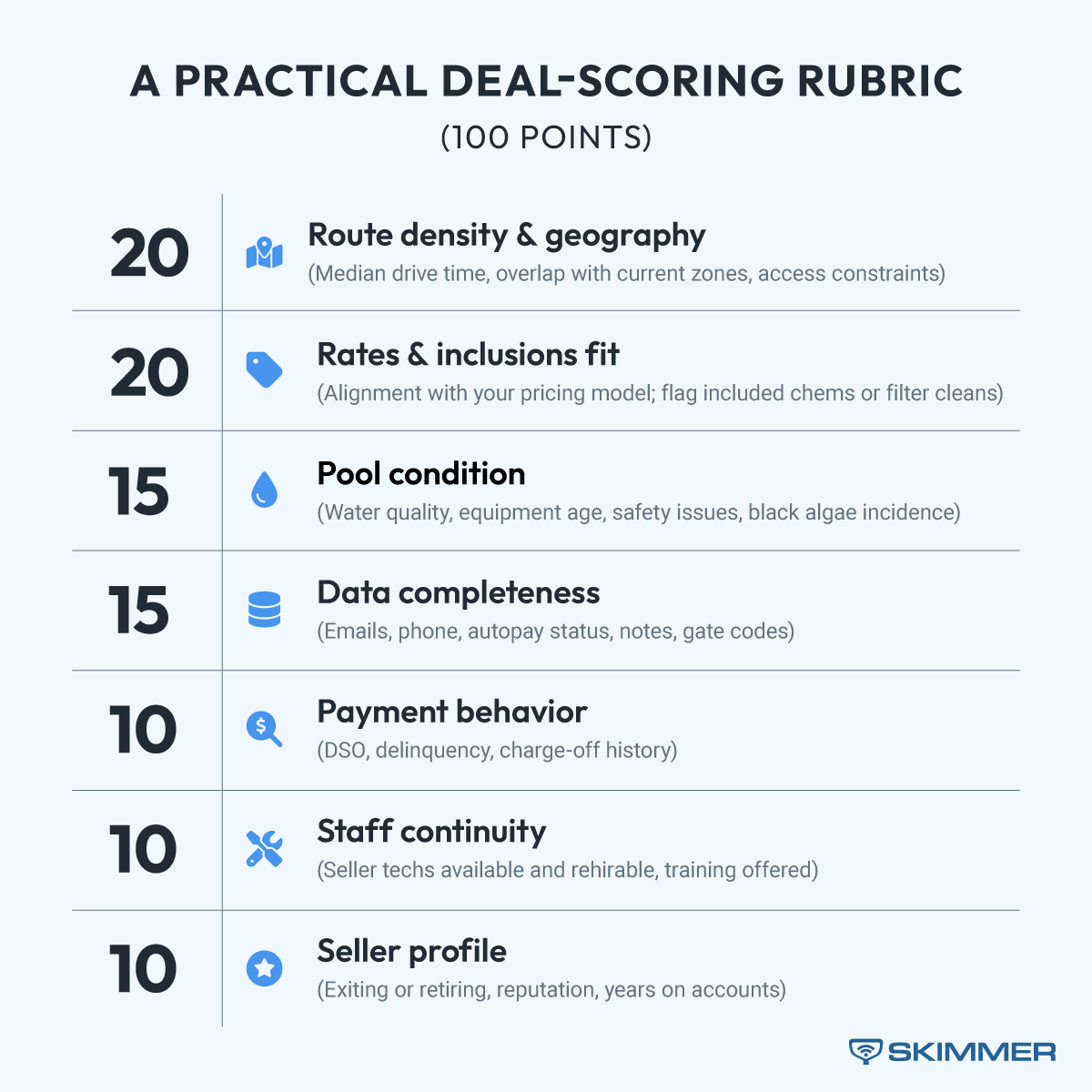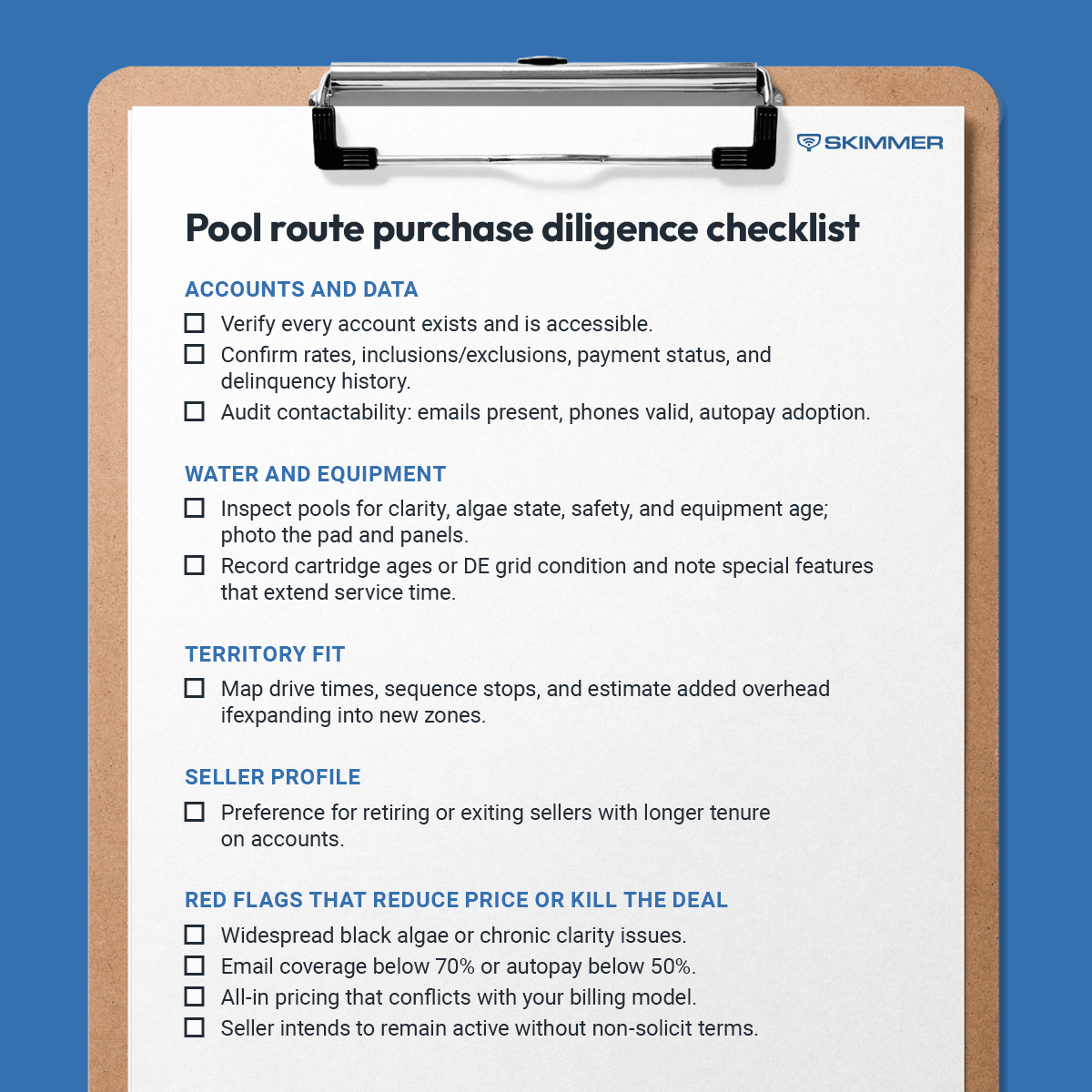
Key takeaways
- Treat a route purchase like a business acquisition. The primary asset is goodwill (customer relationships), not trucks or equipment.
- Local markets often price routes around 6–12× monthly service revenue, excluding repairs. Density, rates, data quality, and pool condition move the multiple up or down.
- Financing options include SBA loans, home‑equity lines, seller financing, and broker‑assisted transactions for first‑time buyers.
- Use contracts that itemize accounts, define guarantees, include non‑solicit/non‑compete terms, and detail the transition plan.
- Do structured due diligence: verify pools, assess water/equipment, review rates and payment hygiene, and map density.
- Run a disciplined handoff: aligned billing, customer communication, technician introductions, and a data‑driven price plan around the 6‑month mark.
For many pool and spa service professionals, buying a pool route is one of the fastest paths to business growth. A well-chosen acquisition can expand a company’s customer base overnight, add recurring revenue, and tighten service density. But for those new to route buying, it can also feel complex.
This guide breaks down how route acquisitions work, what determines their value, and how to ensure a smooth transition once the deal closes. Drawing on the experiences of successful operators who’ve grown their businesses through acquisitions, it’s designed to help pool pros understand what to look for, what to avoid, and how to make a pool route purchase pay off.
1. Key definitions you need to know before buying a route
When you buy a pool route, you’re not buying trucks, equipment, or a building—you’re buying relationships. A route is essentially a list of paying customers who rely on weekly pool service. The primary asset is goodwill: the trust, loyalty, and consistency built between those customers and the previous owner.
Because goodwill is intangible, most route purchases are structured as asset acquisitions. In accounting terms, that means the purchase price is allocated mainly to goodwill and amortized over time. The value of the deal lies in the recurring revenue those accounts generate month after month.
Experienced buyers often describe a route purchase as “acquiring cash flow.” What they’re really buying is the stability and predictability of that income stream, as well as the efficiency that comes from having multiple pools close together on the same schedule. Dense, well-planned routes cut down on windshield time and raise margins, making them far more valuable than scattered accounts.
Two metrics matter most at this stage:
- Customer retention rate: how long customers tend to stay with the company.
- Density: how many accounts can be serviced within a small area.
High retention and tight density are signs of a healthy, profitable route.
Important definitions at-a-glance
- Pool route: A set of recurring service accounts, including names, addresses, rates, visit cadence, and service history.
- Goodwill: The value of customer relationships and the seller’s agreement to transition accounts. In the U.S., goodwill typically amortizes over 15 years for tax purposes.
- Multiple: Price paid as a multiple of monthly service revenue for the included accounts (repairs excluded).
- Guarantee period: A defined window after closing, often ~3 months, that obligates replacements or refunds for lost or non‑paying accounts per the contract.
- Non‑solicit / non‑compete: Clauses that prevent remarketing the same accounts or re‑entering the area in ways that undermine the deal.
2. Approaches to buying and selling pool routes
Pool route transactions happen in two main ways: through brokers or private sales.
Brokered sales
In a brokered deal, a licensed third party facilitates the transaction. Brokers often hold funds in escrow, verify account data, and structure the transition so both buyer and seller are protected. For many first-time buyers, working with a broker can reduce the fear of “buying nothing tangible.” Most brokers charge a fee based on monthly service revenue, typically resulting in the seller receiving around ten months of revenue and the buyer paying twelve, with the broker keeping the difference.
Private sales
Experienced owners sometimes buy or sell routes directly. Routes are frequently advertised on Craigslist, Facebook Marketplace, or industry bulletin boards. In many cases, deals happen through word of mouth—owners simply make it known they’re looking to grow through acquisition. Building a reputation as a serious, reliable buyer often attracts opportunities before they’re listed publicly.
Financing a purchase
Because goodwill doesn’t serve as collateral, traditional business loans can be difficult to secure. Buyers often explore alternatives such as:
- Home‑equity lines for buyers with the risk tolerance and equity to support them.
- Seller financing, where the seller carries the note and the buyer repays over time
- SBA loans for established operators with documented revenue and tax returns
- Broker‑assisted first purchases to add process and confidence for newcomers. If this is your first time buying, working with a broker or seller willing to finance can provide structure and confidence without requiring full payment up front.

3. What is a pool route worth? Valuation and ROI
The first question most people ask is: how much do pool routes cost?
Across the industry, routes typically sell for six to twelve times monthly service revenue (repairs and one-off jobs are often excluded from that calculation). A route grossing $10,000 per month in service might therefore sell for between $60,000 and $120,000, depending on several factors.
What affects the multiple on a pool route?
- Geographic fit and density: Routes that mesh well with existing service areas or shorten drive times command higher multiples.
- Customer data quality: Verified emails, active credit cards, and autopay usage add value.
- Pool condition and equipment: Well-maintained pools with modern systems reduce risk and startup costs.
- Rate structure: Routes charging market-rate pricing are more valuable than underpriced accounts.
- Seller profile: Routes sold by retiring owners with long-term customers tend to retain clients more easily.

How to calculate payback
The real question behind any acquisition is how long it will take to earn back what you spend. A simple rule of thumb is:
Payback period (in months) = Purchase multiple ÷ Net service margin.
If a route costs 6× monthly revenue and operates at a 30% margin, payback takes about 20 months. At 10×, that stretches closer to 33 months. Many pros model their investment based solely on recurring service revenue and treat repairs as upside, not part of the baseline ROI.
Payback math you can trust
- Service‑only rule of thumb: Payback months = Multiple ÷ service margin.
- Examples: 6× at 30% margin → ~20 months; 10× at 30% margin → ~33 months.
- If you include repairs, add repair profit to monthly profit. Example with 50 pools at $130/month (service $6,500) plus $3,000/month repairs at 40% margin: monthly profit ≈ $1,950 (service) + $1,200 (repairs) = $3,150; 6× price ($39,000) → ~12.4 months; 10× price ($65,000) → ~20.6 months. Make the go/no‑go decision on service‑only math, then test upside with sensitivity runs.
Modeling attrition
Even a smooth transition brings some churn. Buyers often plan for 5–20% customer loss in the first 90 days, depending on how rates and expectations align. A detailed communication plan can minimize that risk.
When underpriced pools still make sense
Some buyers intentionally acquire underpriced accounts that fill geographic gaps or complete existing routes. If a group of pools is in a perfect location, it can still be a smart purchase—provided there’s a plan to raise rates within six to twelve months.
Get Skimmer’s customer acquisition ROI calculator to help understand your deal metrics
4. Contracts and agreements: How to structure the deal
A solid contract protects both parties and outlines exactly what’s being bought and sold. While templates abound, every deal should be reviewed by an attorney familiar with local regulations.
A standard purchase agreement includes:
- A bill of sale for the accounts
- An exhibit listing each customer, address, rate, service schedule, and payment status
- Guarantee terms, typically three months, ensuring replacements or refunds for lost accounts
- A non-solicitation or non-compete clause to prevent the seller from reclaiming customers
- Details on data transfer, including customer contact information and recent invoices
- Any holdback of funds—commonly 10–20% of the purchase price—released once the guarantee period ends
Access a bill of sale non-solicitation agreement example here. Please note that this is an example only. Please consult an attorney.
Trust plays a major role in smaller deals. Many veteran owners prefer buying from people they already know in the local pool community. Strong relationships make it easier to handle hiccups or customer questions during the transition.
5. Due diligence checklist
Before money changes hands, due diligence is critical. Every pool should be verified, every rate confirmed, and every assumption tested.
Account verification: Buyers should confirm that each listed customer exists, that contact details are valid, and that billing is current. Reviewing a few months of service invoices provides insight into payment patterns and any late accounts.
Pool inspection: Walk or ride along on at least one full-service day. Look for equipment age, safety issues, and signs of chronic neglect such as black algae or poor water balance. These observations directly affect chemical cost and service time.
Territory fit: Map every account to evaluate drive times. Even profitable routes lose value if they spread your team too thin.
Seller profile: Routes sold by owners who are retiring or exiting the business entirely are often safer bets than those offloading “problem pools” or leaving the industry temporarily.

6. After the acquisition: Transition and retaining your new customers
Closing the deal is only half the job. What happens in the first three months determines whether you keep or lose the customers you just paid for.
Communicate early and often
A two-step introduction works best. First, the seller sends a note to all customers announcing the transition and introducing the new company. Then, the buyer follows up with a welcome email outlining service days, communication channels, and billing procedures.
Because most customers are loyal to their current provider, a warm handoff reassures them that service quality will continue. It’s also an ideal moment to highlight benefits like digital service reports, autopay, or online scheduling.
Transition letter templates:
The first 90 days
Think of the first three months as an onboarding period for both you and your new clients.
- Days 1–30: Move customers to digital invoicing and autopay. Track service consistency and customer feedback.
- Days 31–60: Audit profitability per stop. Use route-management software to flag underpriced or high-maintenance accounts.
- Days 61–90: Begin adjusting pricing for accounts below your target margin, supported by clear data and improved service documentation.
Pricing and policy alignment
Many new owners wait six months before implementing rate changes, allowing time to establish trust. When it’s time, use consistent logic and clear communication. Explain that pricing updates reflect chemical costs, labor, and the value of professional service.
Pricing architecture that scales
- Consider offering two or three tiers with clear inclusions and exclusions.
- Include a zone factor for long‑distance areas.
- Chemical policy: all‑inclusive or pass‑through with caps and triggers.
- Scheduled filter cleans embedded in the agreement.
- One annual price‑review month to standardize messaging and change management.
Get Skimmer’s price increase toolkit to help with pricing adjustments. It includes a calculator that allows you to see which price increases will keep you profitable, as well as templates for communicating a price increase.
People and operations
If employees come with the acquisition, invest in training and safety from day one. Align them on chemical handling, service standards, and reporting processes. A motivated, consistent field team is key to customer retention.
Proven talent retention strategies
- Offer stay bonuses to proven seller techs and a 90‑day training path to ensure methods and reports meet your standards.
- Align compensation with on‑time completion, quality scores, and low revisit rates.
- Publish a written safety program covering chemical handling, PPE, heat‑illness prevention, and lifting technique.
Seasonal preparation
In regions with extreme weather, plan early for storms or freezes. Communicate policies for suspended service, cleanup pricing, and emergency access well in advance. Consistency builds confidence during unexpected events.
7. Quick reference checklist for pool route buyers
Before buying a pool route, make sure you’ve covered the essentials:
- Define target territory and density goals.
- Know your CAC and target margins.
- Line up financing and underwriting documents.
- Verify monthly service revenue, inclusions, and payment history.
- Model ROI at 6–12× using service‑only math and test sensitivity.
- Score density, rates, condition, data, and seller profile with the rubric.
- Draft contract with exhibit of accounts, guarantee and holdback, non‑solicit, data standard, and repairs handling.
- Inspect pools and equipment; ride along to time stops and drives.
- Map routes and overhead; confirm handoff calendar.
- Send seller announcement and buyer welcome with service agreement and autopay.
- Track KPIs for 90 days; schedule a price review for under‑MVR accounts.
Conclusion: Is buying a pool route a good idea?
For many operators, buying a pool route is one of the most reliable ways to accelerate growth. It’s a proven model for both newcomers and established companies looking to scale. When done carefully, with solid contracts, fair pricing, and a thoughtful handoff, it provides recurring revenue, stronger density, and long-term customer relationships that are difficult to replicate through marketing alone.
However, not every route is created equal. Poorly maintained accounts, weak customer data, or routes spread across a wide geography can turn a promising investment into a costly distraction. The key is understanding your numbers, doing the legwork, and approaching each purchase as a business acquisition, not a gamble.
Buying a pool route can be one of the smartest moves a service professional makes—but only when it’s approached with clear expectations and solid systems. With proper valuation, sound contracts, and a data-driven transition plan, a pool route purchase becomes a strategic growth move rather than a risky leap.
Tools like Skimmer make it easier to manage every step—from evaluating potential deals to retaining customers once you take over. For pool pros ready to expand, understanding how much pool routes cost and what makes them valuable is the first step toward building a stronger, more efficient business.
Ready to explore your next growth move? Visit Skimmer’s resource center to learn more about tools, pricing strategies, and community insights from pros who’ve successfully scaled through acquisitions.
Resources related to this content
- Connect with other pool pros looking to buy and sell routes in The Pool Deck Community
- Skimmer’s customer acquisition ROI calculator
- Example bill of sale non-solicitation agreement
- Transition letter template: Email from sellers
- Transition letter template: Email from buyers
- Skimmer’s price increase toolkit
- [Webinar] Route to Success: Strategies & Considerations for Buying and Selling Pool Routes

















